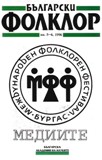Телевизионният фолклор – между илюзията и театъра
Television Folklore between Illusion and Theatre
Author(s): Stefka Petkova-KalevaSubject(s): Anthropology
Published by: Институт за етнология и фолклористика с Етнографски музей при БАН
Summary/Abstract: Television is the most active socializing device in the hierarchy of 20th century inventions. It assists the communication rearranging semantically the facts and self-analyses. The discussion on the relation television – folklore has two main basic points: 1. Usage of folklore topoi and communicative models to enter the codes of conscience by their resistant stereotypes. Therefore everything has been used as а TV message: the resistance of folklore images, the repetition of verbal formulae, the transmission of ready meaning segments (excerpts merging from а piece of work to another); opposition left- right (male–female) when constructing the TV image, the personage-mask (acting as а function of а certain institution and determining culture norms, social and mythologizing structures of the stream creations in time. Television becomes а part of the social carnival and can be differed as an emissary of folklore traditions. 2. Transmission of a folklore fact (model) on the screen thus changing its functions and entering а new stage of socialization. The electronic carnival substitutes the traditional model and introduces illusion as reality. The folklore fact (model) is tilled according to the rules of unfamiliar to it structures. It is not fixed. It is being decoded in а synchrony time, differing from its diachronic time. Television turns folklore into an art. According to the aims of the communicator two main models are accomplished: а reproductive one (reportage reproach when interpreting the events) and а productive one (creating an information-art system) The new television forms are hybrids between traditional genres, poetic structures with complicated coding – rhetoric shrinking and extending of the chronotop, aestheticizing the message, parathethralityt. All that remains is to find how to find а key to the model and to arise the interest of the recipient, but this is always different…
Journal: Български фолклор
- Issue Year: XXII/1996
- Issue No: 5-6
- Page Range: 41-45
- Page Count: 5
- Language: Bulgarian
- Content File-PDF

